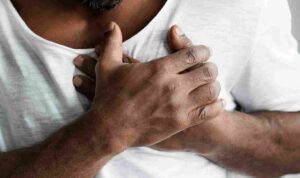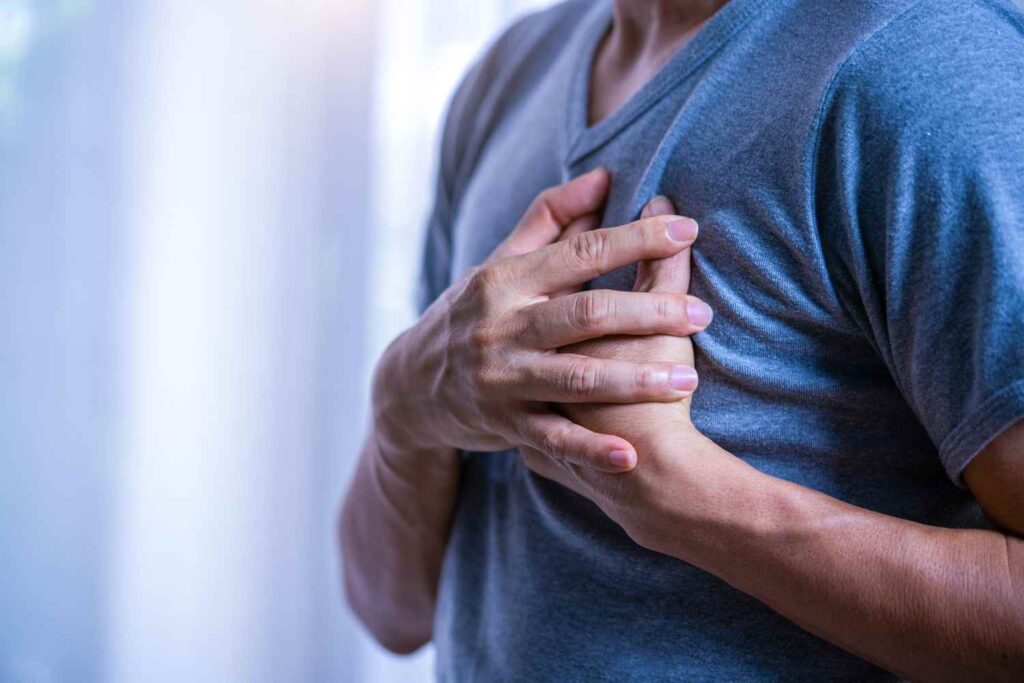Ever felt a tightness in your chest that made you stop for a moment and wonder—Is this just stress, or something more serious? You’re not alone. Many people brush off angina chest pain, thinking it’s just a passing discomfort, but sometimes, it’s your heart trying to tell you something important.
So, how do you know when to worry about chest pain? What triggers angina, and what can you do about it? Let’s break it down in a way that makes sense—no complicated medical jargon, just real talk about heart health.
Contents
What is Angina Chest Pain?
 Angina is a type of chest pain that happens when your heart isn’t getting enough oxygen-rich blood. Think of it like your heart running low on fuel—just like a car struggles without gas, your heart struggles without enough blood flow. This can cause a tight, heavy, or squeezing feeling in your chest.
Angina is a type of chest pain that happens when your heart isn’t getting enough oxygen-rich blood. Think of it like your heart running low on fuel—just like a car struggles without gas, your heart struggles without enough blood flow. This can cause a tight, heavy, or squeezing feeling in your chest.
It’s not a disease on its own but a warning sign that something isn’t right, usually because of narrowed or blocked arteries. Angina can happen during physical activity, stress, or even in cold weather. While it’s not always a heart attack, it’s definitely a red flag that you shouldn’t ignore.
Warning Signs of Angina Chest Pain
Now, let’s talk about a few warning signs that can help you recognize angina early and take action before it becomes a serious heart problem because Angina doesn’t always feel the same for everyone. Some people experience intense pressure, while others might feel mild discomfort that comes and goes.
1. Chest Discomfort – A feeling of pressure, tightness, squeezing, or burning in the chest. It often happens during physical activity or stress and goes away with rest.
2. Pain Spreading to Other Areas – The discomfort may move to the arms (especially the left one), shoulders, neck, jaw, back, or even the stomach.
3. Shortness of Breath – Feeling out of breath even with mild activity, like climbing stairs or walking a short distance.
4. Dizziness or Lightheadedness – A sudden feeling of weakness or like you might faint.
5. Nausea or Sweating – Breaking out in a cold sweat or feeling nauseous without any obvious reason.
6. Fatigue – Feeling unusually tired, even when you haven’t done much physical work.
If you notice these symptoms, especially if they happen often or get worse, don’t ignore them. Angina is your body’s way of signaling that your heart needs attention. Seeking medical help early can prevent serious heart problems down the road.
Can ECG Detect Angina?
Many of you may have wondered, “Can an ECG detect angina?” The answer is—sometimes, but not always.
An electrocardiogram (ECG or EKG) is a test that records the electrical activity of your heart. It can help doctors spot problems like irregular heartbeats or signs of a previous heart attack. However, angina is a temporary condition that occurs when your heart isn’t getting enough blood flow at a certain moment. If your ECG is done when you’re not having symptoms, it might look completely normal.
That’s why doctors may recommend additional tests, like a stress test (where your heart is monitored while you exercise) or an angiography (which checks for blocked arteries). If you’ve been having chest pain or discomfort, don’t rely on just one test—talk to your doctor about the best way to get a clear diagnosis.
Angina in Women
Many people think of angina as just chest pain, but for women, the warning signs can be quite different—and sometimes, more subtle. Because of this, angina in women is often overlooked or mistaken for other issues like anxiety, indigestion, or even extreme fatigue.
Here are some key symptoms women should watch out for:
- Sharp, Burning, or Stabbing Pain
- Pain in the Neck, Jaw, or Upper Back
- Shortness of Breath Without Chest Pain
- Unusual Fatigue
- Nausea, Dizziness, or Cold Sweats
Because women’s symptoms don’t always match the “textbook” signs of angina, they might not seek help right away. But ignoring these signals can be dangerous. If something feels off, trust your body and get checked by a doctor—it could be your heart trying to tell you something important.
How can I Treat Angina Chest Pain?
 Treating angina isn’t just about relieving pain—it’s about improving blood flow to your heart and preventing serious heart problems. Here’s how it’s done:
Treating angina isn’t just about relieving pain—it’s about improving blood flow to your heart and preventing serious heart problems. Here’s how it’s done:
1. Lifestyle Changes (Your First Line of Defense)
- Eat Heart-Healthy Foods – Focus on fruits, vegetables, whole grains, lean proteins, and healthy fats. Cut down on processed foods, excess salt, and unhealthy fats.
- Stay Active – Regular exercise helps keep your heart strong, but always check with your doctor about what’s safe for you.
- Quit Smoking & Limit Alcohol – Smoking narrows your blood vessels, making angina worse. Reducing alcohol intake also helps in maintaining heart health.
- Manage Stress – Deep breathing, meditation, or even a short walk can help reduce stress and prevent angina episodes.
2. Medications to Manage Angina
- Nitrates (like Nitroglycerin) – Helps relax and widen blood vessels, improving blood flow to the heart.
- Beta-Blockers & Calcium Channel Blockers – These help lower heart rate and blood pressure, reducing the heart’s oxygen demand.
- Aspirin & Blood Thinners – Helps prevent blood clots that can lead to heart attacks.
- Statins – Lowers cholesterol and reduces plaque buildup in arteries.
3. Medical Procedures for Severe Cases
- Angioplasty & Stenting – A procedure where a tiny balloon is used to open blocked arteries, followed by placing a small stent to keep the artery open.
- Bypass Surgery – In severe cases, doctors may create a new pathway for blood to flow around blocked arteries.
4. When to See a Doctor?
If you experience chest pain that doesn’t go away with rest or medication, worsens over time, or happens even when you’re not active, seek medical help immediately. It could be a sign of something more serious.
Making small but consistent changes in your lifestyle, following your doctor’s advice, and taking the right medications can help you manage angina and keep your heart healthy for the long run!
What Not to Eat with Angina?
If you have angina, choosing the right foods can help keep your heart healthy and prevent further complications. Some foods can increase cholesterol, raise blood pressure, and cause inflammation, making angina worse.
This is why you should avoid:
- Fast food (burgers, fries, fried chicken)
- Packaged snacks (chips, crackers, cookies)
- Fatty cuts of red meat (pork, lamb, beef with visible fat)
- Full-fat dairy (butter, cheese, cream, whole milk)
- Margarine & hydrogenated oils
- Processed meats (sausages, bacon, salami, ham)
- Canned soups & instant noodles
- Pickles & salty condiments (soy sauce, ketchup, mayonnaise)
- White bread, pasta, pastries, cakes
- Sugary drinks (sodas, energy drinks, sweetened teas, fruit juices with added sugar)
- Candies & desserts
- Heavy alcohol consumption
And, you must choose healthier instead:
- Opt for fresh fruits, vegetables, whole grains, lean proteins (like fish & chicken), nuts, and healthy fats (olive oil, avocados).
- Drink plenty of water and herbal teas instead of sugary or caffeinated drinks.
- Use herbs and spices instead of excess salt for flavoring meals.
Making these small dietary changes can go a long way in keeping your heart healthy and reducing the frequency of angina episodes.
Closing Thoughts
Remember, your heart works hard for you every day—so taking care of it should be a top priority. Managing angina isn’t just about relieving pain; it’s about making heart-healthy choices that can improve your overall well-being and prevent serious complications.
Hence, if you ever experience persistent chest pain or have concerns about your heart health, don’t ignore the signs. Seeking medical advice early can make a big difference.
For expert guidance, MantraDoc is here to help. Our experienced cardiologists can provide the right consultation, diagnosis, and treatment to keep your heart strong and healthy.

